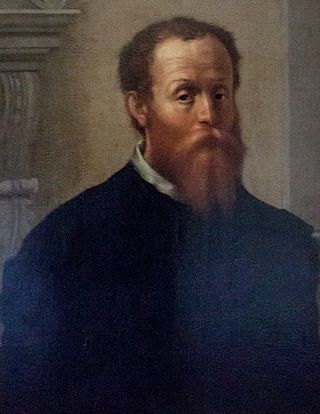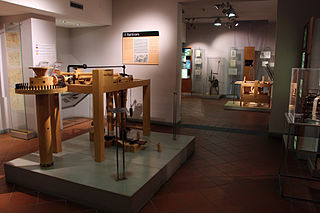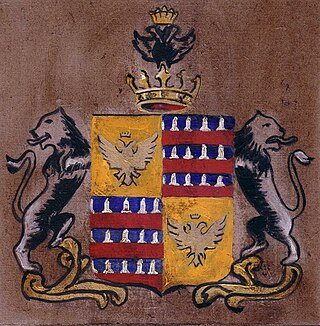Related Research Articles

Leonardo di ser Piero da Vinci was an Italian polymath of the High Renaissance who was active as a painter, draughtsman, engineer, scientist, theorist, sculptor, and architect. While his fame initially rested on his achievements as a painter, he also became known for his notebooks, in which he made drawings and notes on a variety of subjects, including anatomy, astronomy, botany, cartography, painting, and paleontology. Leonardo is widely regarded to have been a genius who epitomized the Renaissance humanist ideal, and his collective works comprise a contribution to later generations of artists matched only by that of his younger contemporary, Michelangelo.

The Mona Lisa is a half-length portrait painting by Italian artist Leonardo da Vinci.

Baccio Bandinelli, was an Italian Renaissance sculptor, draughtsman, and painter.

The Battle of Anghiari (1505) was a planned painting by Leonardo da Vinci in the Salone dei Cinquecento in the Palazzo Vecchio, Florence. Its central scene would have depicted four men riding raging war horses engaged in a battle for possession of a standard at the Battle of Anghiari in 1440.

John Thomas Spike is an American art historian, curator, and author, specializing in the Italian Renaissance and Baroque periods. He is also a contemporary art critic and past director of the Florence Biennale.
James H. Beck was an American art historian specialising in the Italian Renaissance. He was an outspoken critic of many high-profile restorations and re-attributions of artworks, and founded the pressure group ArtWatch International to campaign against irresponsible practices in the art world.

The Accademia delle Arti del Disegno is an academy of artists in Florence, in Italy. It was founded on 13 January 1563 by Cosimo I de' Medici, under the influence of Giorgio Vasari. It was initially known as the Accademia e Compagnia delle Arti del Disegno. It was made up of two parts: the company was a kind of guild for all working artists, while the academy was for more eminent artistic figures of the Medici court, and supervised artistic production in the Duchy of Florence.

Andrea del Sarto was an Italian painter from Florence, whose career flourished during the High Renaissance and early Mannerism. He was known as an outstanding fresco decorator, painter of altar-pieces, portraitist, draughtsman, and colorist. Although highly regarded during his lifetime as an artist senza errori, his renown was eclipsed after his death by that of his contemporaries Leonardo da Vinci, Michelangelo, and Raphael.

La Bella Principessa, also known as Portrait of Bianca Sforza, Young Girl in Profile in Renaissance Dress and Portrait of a Young Fiancée, is a portrait in coloured chalks and ink, on vellum, of a young lady in fashionable costume and hairstyle of a Milanese of the 1490s. Some scholars have attributed it to Leonardo da Vinci but the attribution and the work's authenticity have been disputed.

The Lucan portrait of Leonardo da Vinci is a late 15th- or early 16th-century portrait of a man that was discovered in 2008 in a cupboard of a private house in Italy.

La Scapigliata is an unfinished painting generally attributed to the Italian High Renaissance artist Leonardo da Vinci, and dated c. 1506–1508. Painted in oil, umber, and white lead pigments on a small poplar wood panel, its attribution remains controversial, with several experts attributing the work to a pupil of Leonardo. The painting has been admired for its captivating beauty, mysterious demeanor, and mastery of sfumato.
Leonardo da Vinci's Mona Lisa is one of the most recognizable and famous works of art in the world, and also one of the most replicated and reinterpreted. Mona Lisa replicas were already being painted during Leonardo's lifetime by his own students and contemporaries. Some are claimed to be the work of Leonardo himself, and remain disputed by scholars. Prominent 20th-century artists such as Marcel Duchamp and Salvador Dalí have also produced derivative works, manipulating Mona Lisa's image to suit their own aesthetic. Replicating Renaissance masterpieces continues to be a way for aspiring artists to perfect their painting techniques and prove their skills.

Giovanni Fontana is an Italian poet, performance artist, author and publisher.

The Museo Ideale Leonardo da Vinci is located in Vinci, Leonardo da Vinci's birthplace, in the province of Florence, Italy. It is part of the Museo Leonardiano di Vinci.

The Gherardini of Montagliari was one of the most prominent historical Italian noble families from Tuscany, Italy. Through the Amideis, the family was of Roman descent. Between the 9th and 14th centuries, they played an important role in Tuscany. Its influence was also felt in the Veneto and Emilia regions between the 16th and 18th centuries, and during the Italian Risorgimento as well as in today's Italian politics and economy. The family’s restless and fighting nature has aroused the curiosity of many historians of the Middle Ages. Originating from feudal tradition, it was one of the founding families of the Republic of Florence.

Maria Callani was an Italian portrait painter, active in the 18th century in Milan and Parma, Italy.

Leonardo da Vinci: The Mind of the Renaissance is a 1996 illustrated biography of Leonardo da Vinci authored by the Italian art critic Alessandro Vezzosi, translated from Italian into French by Françoise Liffran, and published by Éditions Gallimard in the same year as the 293rd volume in their "Découvertes" collection. The book was adapted into a documentary film in 2001, by the title Léonard de Vinci.

The Museo Leonardiano di Vinci, or Leonardian Museum of Vinci, is a museum dedicated to Leonardo da Vinci, located in Vinci, Leonardo's birthplace, in the province of Florence, Italy.

The Da Vinci family is an Italian family from Vinci, Tuscany.
References
- ↑ Accademici d'Onore Archived 19 June 2013 at the Wayback Machine (in Italian). Accademia delle Arti del Disegno, Florence. Accessed June 2013.
- ↑ "È lui, Michelangelo Gli esperti diranno se è un autoritratto". Archived from the original on 16 July 2020. Retrieved 18 June 2016.
- ↑ "L'autoritratto di Michelangelo" Una scultura data all'artista Archived 9 August 2016 at the Wayback Machine